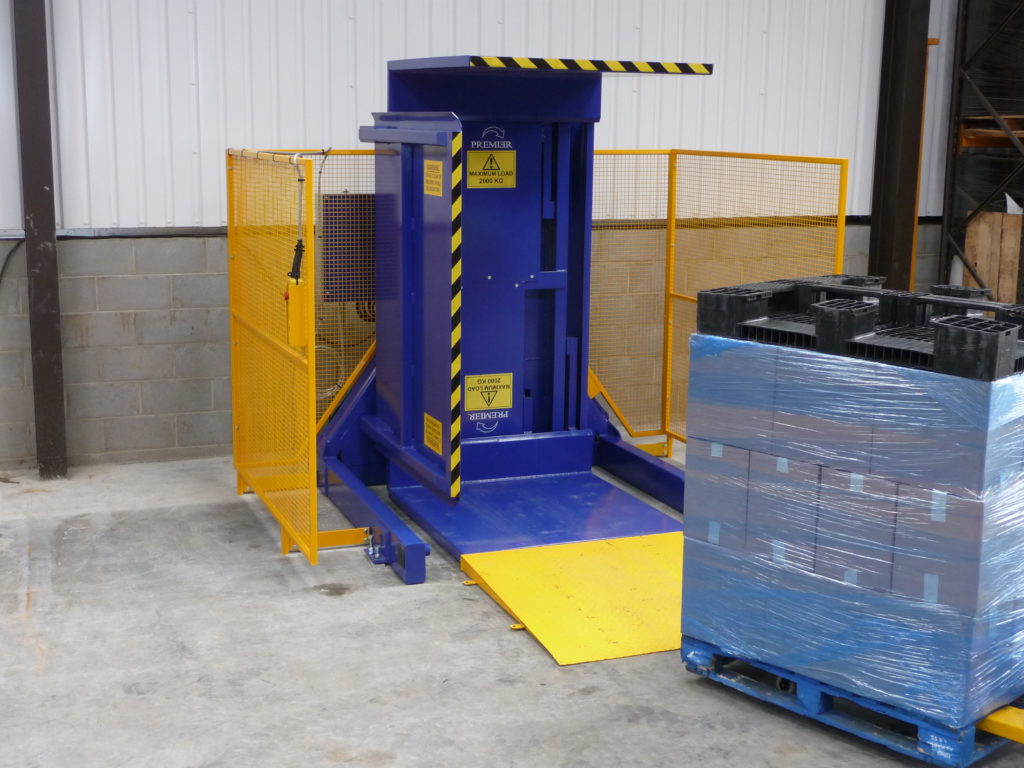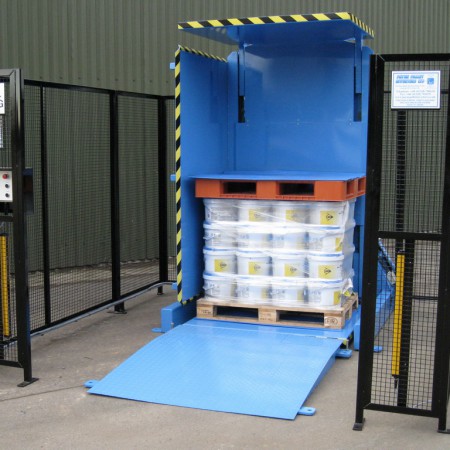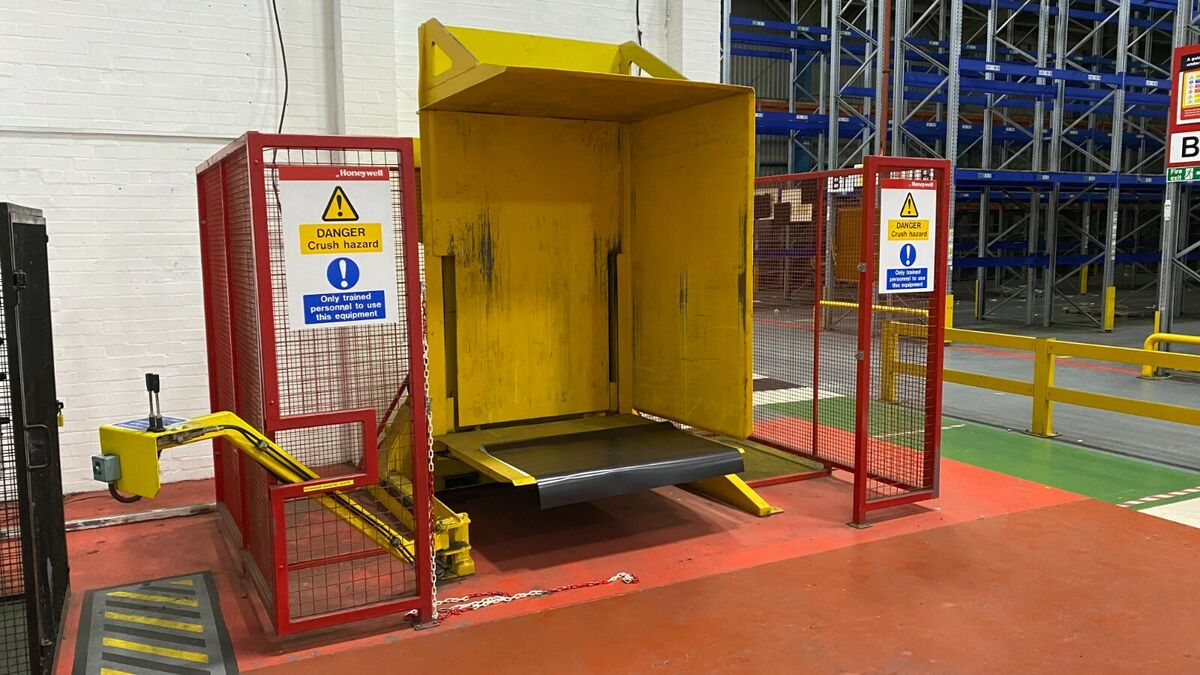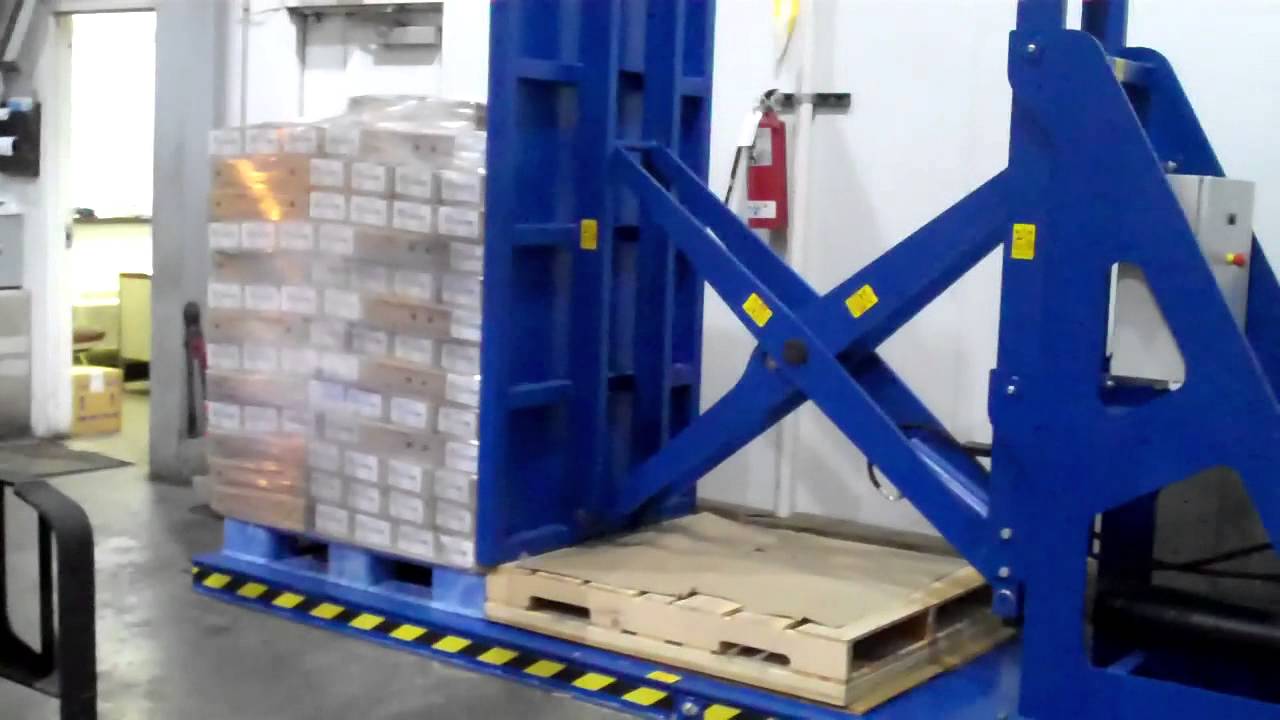From Manual to Smart: Pallet Inverters Transforming Spain's Material Handling
Is your warehouse floor a constant source of inefficiency? Many businesses in Spain still depend on manual labor to transfer goods from one pallet to another. This traditional approach is not just slow; it's a hidden drain on your resources. You see your team working hard, but behind the scenes, you're losing time to slow processes, money to damaged products, and risking the well-being of your employees with every heavy lift. This method, once the standard, is now a bottleneck holding your business back. It's time to consider a smarter way, a solution that transforms this weak link into a source of strength and efficiency for your entire operation.
Pallet inverters are transforming material handling in Spain by automating the process of transferring loads between pallets. This shift from manual labor to smart technology directly tackles major operational challenges. These machines increase speed, significantly cut labor costs, improve worker safety by eliminating strenuous lifting, and protect product integrity during transfer. For Spanish industries aiming to compete globally, adopting pallet inverters is a critical step toward modernizing warehouse logistics, reducing operational bottlenecks, and boosting overall productivity.

I've seen this transformation firsthand. For years, I've worked with factory owners who were stuck in old habits, thinking "if it isn't broken, don't fix it." But the truth is, in today's market, if it isn't optimized, it is broken. This isn't just about buying a new machine; it's about adopting a new philosophy for your material handling. Let's explore why this change is so crucial and what it can mean for your business's future.
Why are traditional pallet handling methods no longer sufficient for Spanish industries?
You might be looking at your current operations and thinking that manual restacking works just fine. Your team gets the job done, and it’s a process you’ve used for years. But have you ever truly calculated the hidden costs? Think about the time it takes for two workers to break down and restack a full pallet. Think about the risk of back injuries and the potential for expensive compensation claims. And what about the goods that get dropped or damaged in the process? In the highly competitive Spanish and European markets, these small, persistent inefficiencies are like a slow leak, draining your profits day after day. It's a problem that grows quietly until it becomes a major barrier to growth.
Traditional pallet handling methods are no longer sufficient for Spanish industries because they fail to meet modern demands for speed, safety, and cost-efficiency. Manual restacking is inherently slow, physically taxing, and susceptible to human error. This creates significant bottlenecks in the supply chain, increases operational costs, and puts workers at risk, making it an outdated practice in a fast-paced, competitive global market.

The True Cost of "The Old Way"
When I talk to plant managers, they often focus on the direct costs they can see on a spreadsheet. But the indirect costs of manual pallet handling are often much larger. Let's break it down.
First, there's the cost of labor. It's not just one person's salary. It often takes two employees to safely destack and restack a heavy pallet. You are paying two people to do a job that a single machine could do in under a minute. This time adds up quickly. If you transfer just 20 pallets a day, you could be losing dozens of hours of productive work every week. That is time your team could spend on quality control, machine maintenance, or other value-added tasks.
Second, the risk to employee health is a huge financial liability. Musculoskeletal injuries from repetitive lifting are one of the most common workplace accidents. A single serious injury can lead to lost workdays, increased insurance premiums, and potential legal fees. It also affects team morale. A safe workplace is a productive workplace. When employees feel the company is investing in their well-being, they are more engaged and motivated.
Finally, consider product damage. No matter how careful your team is, accidents happen when moving heavy loads by hand. A single dropped box or a crushed container can wipe out the profit margin on an entire shipment. This is especially true for high-value goods or fragile items. Manual handling introduces a level of variability and risk that modern logistics aims to eliminate.
Meeting the Demands of a Modern Market
The market in Spain and across Europe has changed. Customers expect faster delivery. Supply chains run on a just-in-time basis. This means there is no room for delays. A bottleneck at the end of your production line, where goods are prepared for shipping, can disrupt your entire schedule.
Furthermore, many industries now have strict hygiene and compliance standards. In the food, beverage, and pharmaceutical sectors, goods often arrive on wooden pallets but must be switched to sanitized plastic or aluminum pallets before entering a cleanroom or production area. Manually transferring these goods is not only slow but also increases the risk of contamination. An automated pallet inverter performs this task quickly and with minimal human contact, ensuring you meet regulatory requirements.
Here is a simple comparison:
| Metric | Manual Pallet Handling | Pallet Inverter Handling |
|---|---|---|
| Time per Pallet | 10-15 minutes (2 workers) | < 1 minute (1 operator) |
| Labor Cost | High (2x salary) | Low (Minimal operator time) |
| Safety Risk | High (Back injuries, strains) | Very Low (Ergonomic design) |
| Product Damage | Moderate to High | Very Low |
| Process Control | Low (Depends on workers) | High (Consistent, repeatable) |
| Hygiene | Low (High human contact) | High (Minimal contact) |
The data is clear. Traditional methods are a liability in a modern industrial environment.
How do modern pallet inverters boost operational efficiency and safety?
Imagine your production line is running perfectly. Everything is moving smoothly until the very last step: packaging and shipping. Here, you have a pile-up. Goods are waiting to be transferred from your high-quality in-house pallets to cheaper shipping pallets. Or worse, a forklift has damaged a pallet at the bottom of a stack, and now the entire load is unstable and unsafe to move. Everything grinds to a halt. This single bottleneck costs you time and money and introduces a serious safety risk. You know there has to be a better way to handle this final, critical step.
Modern pallet inverters boost operational efficiency by fully automating the transfer of goods between pallets, completing the task in as little as 60 seconds. This massive time-saving reduces labor needs and accelerates the entire logistics workflow. Simultaneously, they enhance safety by eliminating the need for employees to manually lift heavy or awkwardly shaped loads. This simple change drastically reduces the primary cause of musculoskeletal injuries in the workplace.

A New Standard for Workflow and Speed
I started my career on the factory floor, so I understand the importance of a smooth, continuous workflow. A pallet inverter fundamentally changes the dynamic at the end of a production line or in a receiving bay.
Let's look at the process. Manually, a worker has to remove goods layer by layer, place them on a new pallet, and then re-stack them. This is slow and tedious. With a pallet inverter, the operator simply places the entire loaded pallet into the machine. The machine securely clamps the load, rotates it 180 degrees, and allows the old pallet to be removed from the top. The new pallet is placed on top, and the load is rotated back. The entire cycle is complete.
This isn't just a marginal improvement; it's a revolutionary one. We're talking about taking a process that took 15 minutes and reducing it to one minute. This speed has a ripple effect throughout your operation. Trucks are loaded and unloaded faster. Inventory is moved into storage more quickly. Production lines are not left waiting for finished goods to be cleared. This increase in throughput means you can handle more volume without increasing your headcount or floor space. It directly addresses the goal of increasing capacity utilization.
Engineering Safety into the Process
As an engineer, I believe the best way to ensure safety is to design the risk out of the system. That is exactly what a pallet inverter does. The primary safety benefit is the elimination of manual lifting. The machine does all the heavy work. This protects your most valuable asset: your people.
Here are the key safety improvements:
- Ergonomics: The machine is designed for safe operation. The operator uses simple controls from a safe distance, never placing their body under strain.
- Load Stability: The inverter clamps the entire load before tilting, preventing any shifting or falling of goods. This is crucial when dealing with unstable or irregularly shaped items.
- Damaged Pallet Recovery: Trying to manually unload a broken pallet is one of the most dangerous jobs in a warehouse. The pallet inverter secures the load first, allowing the broken pallet to be safely removed and replaced without any risk to the product or the operator.
By investing in this technology, you are making a clear statement to your employees that their safety is a priority. This builds trust and a positive company culture, which are essential for long-term success.
What are the key financial benefits of integrating pallet inverters into the supply chain?
Every business owner, especially someone with an engineering background, looks at a new piece of equipment and immediately asks: "What is the return on investment?" You need to see a clear path from the initial expense to tangible financial gains. It's easy to be skeptical. It's tempting to stick with the current system to avoid a large capital outlay. But this way of thinking can be a trap. While you are "saving" money by not investing, you are losing far more to ongoing inefficiencies, preventable expenses, and missed opportunities. The real question isn't "Can I afford it?" but "Can I afford not to?"
The key financial benefits of integrating pallet inverters are direct and measurable. They include a dramatic reduction in manual labor costs, a significant decrease in financial losses from damaged products, and substantial savings in pallet management. By automating a slow and risky manual task, businesses can reallocate workers to more productive roles, salvage goods that would otherwise be scrapped, and optimize their pallet inventory for maximum cost-effectiveness.

Calculating Your Return on Investment (ROI)
A pallet inverter is not a cost center. It is an investment that generates returns from multiple sources. Let's break down how to calculate its value.
First, labor savings. This is the most straightforward calculation. Determine how many hours your team spends manually handling pallets each day. Multiply that by their loaded wage rate (including benefits and taxes). A pallet inverter can reduce this time by up to 95%. For a business running multiple shifts, this can translate to tens of thousands of euros saved annually, allowing you to reassign your team to tasks that actually grow your business.
Second, product damage reduction. How much money did you lose last year to products damaged during handling? Include the cost of the goods, the labor to clean up the mess, and the disposal fees. A pallet inverter handles loads gently and securely, minimizing this risk. Even a small reduction in product damage can lead to significant savings, especially if you handle high-value items. This is how you salvage goods from a broken pallet and turn a total loss into a saved asset.
Third, pallet inventory optimization. This is a strategy many of my most successful clients use. They use high-quality, durable (and expensive) pallets for internal use within their factory. These pallets last for years. For outbound shipping, they use a pallet inverter to switch the load to a lightweight, inexpensive one-way pallet. This prevents their valuable pallets from being lost or damaged once they leave the facility. The cost difference between a multi-use internal pallet and a cheap shipping pallet can be substantial. Over thousands of shipments, this generates enormous savings.
Let's look at a simple example:
| Cost/Saving Category | Calculation | Annual Impact (Example) |
|---|---|---|
| Labor Savings | (2 Workers x 2 hrs/day x €20/hr) x 250 days | €20,000 |
| Product Savings | (€100 avg. damage/week) x 52 weeks | €5,200 |
| Pallet Savings | (€15 savings/pallet x 20 pallets/day) x 250 days | €75,000 |
| Total Annual Savings | - | €100,200 |
This is a conservative estimate. For a large-scale operation like a steel mill or a major distribution center, the savings would be exponentially larger. The ROI is often achieved in less than 12-18 months.
How can smart pallet inverters support Spain's push for Industry 4.0?
You hear the terms all the time: "Industry 4.0," "digital transformation," "the smart factory." It can all sound very abstract and complicated, far removed from the practical realities of your factory floor. You might wonder how a machine that tilts pallets fits into this high-tech vision. The risk is that if you don't find practical ways to connect your machinery and gather data, your operation will remain a collection of isolated islands. You will lack the visibility needed to truly optimize your processes, predict failures, and make the data-driven decisions that define modern manufacturing.
Smart pallet inverters are a practical and powerful tool for supporting Spain's push into Industry 4.0. They do this by integrating directly with higher-level factory management systems like MES and WMS. Equipped with modern sensors and connectivity options, these machines stop being isolated equipment and start becoming active data points on your network. They provide real-time information on cycle counts, operational status, and maintenance needs, enabling predictive maintenance, full production visibility, and a truly connected logistics workflow.

From a Standalone Machine to a Connected Asset
The essence of Industry 4.0 is data. It's about making your physical operations visible in a digital space. A smart pallet inverter is designed for this. It's not just a mechanical device; it's an intelligent node in your factory's network.
The most important feature is its ability to integrate with your Manufacturing Execution System (MES) or Warehouse Management System (WMS). Here’s how it works: when a pallet is successfully transferred, the inverter can automatically send a signal to your central system. This signal can trigger a series of events: the inventory count is updated, the WMS directs a forklift or an AGV to the pallet's location, and the MES logs the completion of that production step. This eliminates the need for manual scanning or data entry, which not only saves time but also removes the potential for human error. It creates a seamless flow of information that mirrors the physical flow of goods.
The Power of IoT Sensors and Data Analytics
Modern pallet inverters are equipped with a range of IoT (Internet of Things) sensors that collect valuable data. These aren't just for basic operation; they are for intelligence.
- Cycle Counters: Track exactly how many pallets are processed per hour, per shift, or per day. This data is crucial for measuring throughput and identifying performance trends.
- Hydraulic Pressure/Motor Current Sensors: These monitor the health of the machine itself. Instead of waiting for a breakdown, the system can detect subtle changes in performance. An alert can be sent to your maintenance team—for example, "Hydraulic pressure is 5% below optimal, schedule an inspection." This is the core of predictive maintenance, a key goal for any modern factory looking to maximize uptime.
- Load Sensors: Some models can weigh the load during the process, providing valuable data for shipping manifests and quality control.
This data, when fed into an analytics platform, allows you to move from reactive to proactive management. You can visualize your entire end-of-line process, identify hidden bottlenecks, and make informed decisions to improve efficiency. This directly supports the goal of achieving 95% equipment uptime and全面生产可视化 (comprehensive production visualization).
| Pallet Inverter Feature | Industry 4.0 Concept | Benefit for Your Factory |
|---|---|---|
| MES/WMS Integration | System Interoperability | Automated data flow, error reduction |
| IoT Cycle Counter | Real-Time Data | Accurate throughput measurement (KPIs) |
| Predictive Maintenance Sensors | Smart Maintenance | Increased uptime, reduced repair costs |
| Automation-Ready Controls | Full Automation | Integration with AGVs and conveyors |
A smart pallet inverter is more than a machine; it is a gateway to a smarter, more connected, and more profitable way of operating.
My Take: From a Steel Mill Floor to Your Bottom Line
I remember my early years as an engineer, long before I started SHJLPACK. I spent a lot of time in factories, including steel processing plants. The scale was immense. We handled massive coils of steel and other heavy materials. I saw firsthand what happens when a wooden pallet holding tons of product fails. It wasn't just an inconvenience; it was a major safety crisis and a huge financial loss. The only solution we had back then was to get a crew of guys to manually, and very dangerously, restack the entire load. It was slow, risky, and incredibly inefficient.
When I look at the profile of a leader like Javier Morales, I see the same fundamental challenges I saw back then, but magnified to a massive scale. When you are running a 2-million-ton steel mill, you are constantly battling volatile energy costs, aging equipment, and immense pressure to be more efficient. You cannot solve these 21st-century problems with 20th-century methods like manual labor.
A pallet inverter might seem like a small detail in a giant operation. But a truly strategic leader knows that excellence is found in the details. This machine isn't just about swapping pallets. In a steel plant, it's about protecting your valuable finished product from damage during final handling. It’s about keeping your people safe from the risks of handling heavy, unstable loads. Most importantly, it's about eliminating a bottleneck so your primary, multi-million-dollar production lines can run at the high capacity you need.
For a business that measures output in millions of tons, even a tiny 1% improvement in efficiency or a small reduction in product handling damage translates to huge gains on the bottom line. This is a targeted investment. It directly addresses safety, efficiency, and cost—the very things a forward-thinking owner like Javier obsesses over. This is why I built my company not just to sell machines, but to be a strategic partner. We need to understand your challenges and provide solutions that deliver a real, measurable return.
Conclusion
Investing in a pallet inverter is a strategic move towards a safer, more efficient, and smarter material handling operation, securing your competitive edge for the future.



